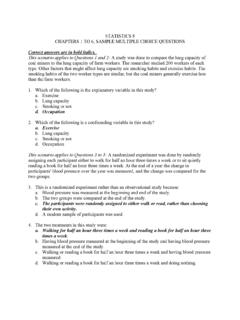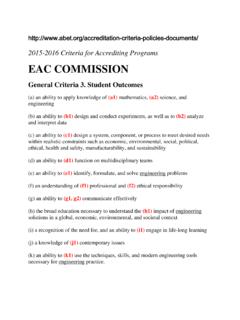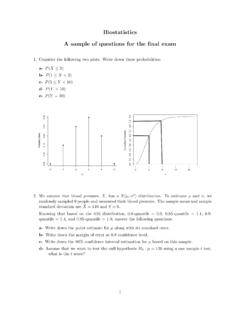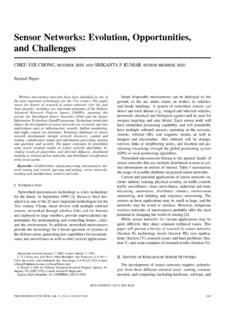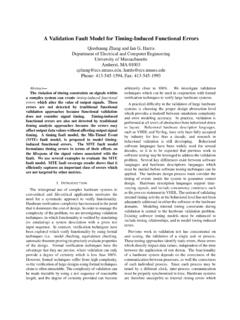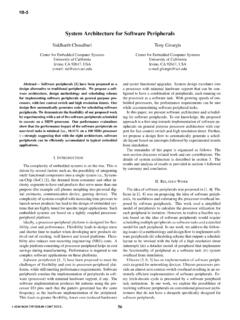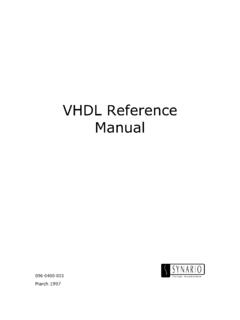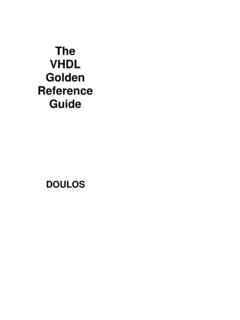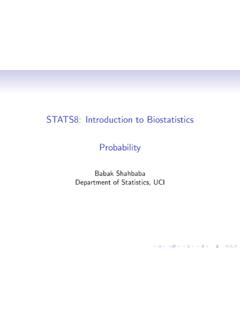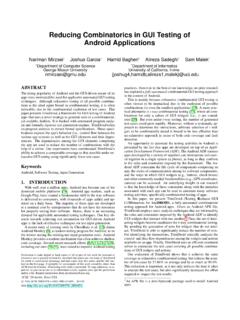Transcription of Introduction to Artificial Intelligence
1 Introduction to Artificial IntelligenceKalev KaskICS 271 Fall 2014271-fall 2014 ~kkask/Fall-2014 CS271/Course requirementsAssignments: There will be weekly homework assignments, a project, a : Homework will account for 20% of the grade, project 30%, final 50% of the : Optional. 2014 Course overview Introduction and Agents (chapters 1,2) Search (chapters 3,4,5,6) Logic (chapters 7,8,9) Planning (chapters 10,11) Uncertainty and probability (chapters 13-14)271-fall 2014 Plan of the coursePart I Artificial Intelligence1 Introduction 2 Intelligent Agents Part II Problem Solving3 Solving Problems by Searching 4 Beyond Classical Search 5 Adversarial Search 6 Constraint Satisfaction Problems Part III Knowledge and Reasoning7 Logical Agents 8 First-Order Logic 9 Inference in First-Order Logic 10 Classical Planning 11 Planning and Acting in the Real World Part IV Uncertainty13 Uncertainly14 Probabilistic Reasoning271-fall 2014 Resources on the internetResources on the Internet AI on the Web:A very comprehensive list of Web resources about AI from the Russell and Norvig textbook.
2 Essays and Papers What is AI, John McCarthy Computing Machinery and Intelligence , Turing Rethinking Artificial Intelligence , Patrick AI Topics: 2014 Today s class What is Artificial Intelligence ? A brief History Intelligent agents State of the art271-fall 2014 Today s class What is Artificial Intelligence ? A brief History Intelligent agents State of the art271-fall 2014 What is Artificial Intelligence (John McCarthy, Basic Questions) What is Artificial Intelligence ? It is the science and engineering of making intelligent machines, especially intelligent computer programs.
3 It is related to the similar task of using computers to understand human Intelligence , but AI does not have to confine itself to methods that are biologically observable. Yes, but what is Intelligence ? Intelligence is the computational part of the ability to achieve goals in the world. Varying kinds and degrees of Intelligence occur in people, many animals and some machines. Isn't there a solid definition of Intelligence that doesn't depend on relating it to human Intelligence ? Not yet. The problem is that we cannot yet characterize in general what kinds of computational procedures we want to call intelligent. We understand someof the mechanisms of Intelligence and not others.
4 More in: 2014 What is Artificial Intelligence ? Human-like vs rational-like Thought processes vs behavior How to simulate humans intellect and behavior by a machine. Mathematical problems (puzzles, games, theorems) Common-sense reasoning Expert knowledge: lawyers, medicine, diagnosis Social behavior Things we would call intelligent if done by a 2014 What is AI?Views of AI fall into four categories:Thinking humanlyThinking rationally Acting humanlyActing rationally The textbook advocates "acting rationally 271-fall 2014 How to simulate humans intellect and behavior by a problems (puzzles, games, theorems)Common-sense reasoningExpert knowledge: lawyers, medicine, diagnosisSocial behaviorThe Turing Test(Can Machine think?)
5 A. M. Turing, 1950) Requires: Natural language Knowledge representation Automated reasoning Machine learning (vision, robotics) for full test271-fall 2014 Humanly/Rationally Turing test (1950) Requires: Natural language Knowledge representation automated reasoning machine learning (vision, robotics.) for full test Methods for Thinking Humanly: Introspection, the general problem solver (Newell and Simon 1961) Cognitive sciences Thinking rationally: Logic Problems: how to represent and reason in a domain Acting rationally: Agents: Perceive and act271-fall 2014 What is Artificial Intelligence Thought processes The exciting new effort to make computers think.
6 Machines with minds, in the full and literal sense (Haugeland, 1985) Behavior The study of how to make computers do thingsat which, at the moment, people are better. (Rich, and Knight, 1991) Activities The automation of activities that we associate with human thinking, activities such as decision-making, problem solving, (Bellman)271-fall 2014 The automation of activities that we associate The foundation of AI271-fall 2014 Philosophy, Mathematics, Economics, Neuroscience, Psychology,Computer Engineering, Features of intelligent system Deduction, reasoning, problem solving Knowledge representation Planning Learning Natural language processing Perception Motion and manipulationTools Search and optimization Logic Probabilistic reasoning Neural networksToday s class What is Artificial Intelligence ?
7 A brief history Intelligent agents State of the art271-fall 2014 Histroy of AI271-fall 2014 McCulloch and Pitts (1943) Neural networks that learn Minskyand Edmonds (1951) Built a neural net computer Darmouthconference (1956): McCarthy, Minsky, Newell, Simon met, Logic theorist (LT)-Of Newell and Simon proves a theorem in Principia Mathematica-Russel. The name ArtficialIntelligence was coined. 1952-1969 (early enthusiasm, great expectations) GPS-Newell and Simon Geometry theorem prover-Gelernter (1959) Samuel Checkers that learns (1952) McCarthy -Lisp (1958), Advice Taker, Robinson s resolution Microworlds: Integration, block-worlds.
8 1962-the perceptron convergence (Rosenblatt)The Birthplace of Artificial Intelligence , 1956 Darmouth workshop, 1956:historical meeting of the precieved founders of AI met: John McCarthy, Marvin Minsky, Alan Newell, and Herbert Simon. A Proposal for the Dartmouth Summer Research Project on Artificial Intelligence . J. McCarthy, M. L. Minsky, N. Rochester, and Shannon. August 31, 1955. "We propose that a 2 month, 10 man study of Artificial Intelligence be carried out during the summer of 1956 at Dartmouth College in Hanover, New Hampshire. The study is to proceed on the basis of the conjecture that every aspect of learning or any other feature of Intelligence can in principle be so precisely described that a machine can be made to simulate it.
9 " And this marks the debut of the term " Artificial Intelligence . 50 anniversery of Darmouth workshop List of AI-topics271-fall 2014 More AI examplesCommon sense reasoning (1980-1990) Tweety Yale Shooting problemUpdate vsrevise knowledgeThe OR gate example: A or B C Observe C=0, vsDo C=0 Chaining theories of actionsLooks-like(P) is(P)Make-looks-like(P) Looks-like(P)--------------------------- -------------Makes-looks-like(P) ---is(P) ???Garage-door example:garage door not included. Planning benchmarks 8-puzzle, 8-queen, block world, grid-space world Cambridge parking exampleSmoked fish what is this?271-fall 2014 History, continued 1966-1974 a dose of reality Problems with computation 1969-1979 Knowledge-based systems Weak vs.
10 Strong methods Expert systems: Dendral:Inferringmolecular structures(Buchanan et. Al. 1969) Mycin: diagnosing blood infections (Shortliffeet. Al, certainty factors) Prospector: recommending exploratory drilling (Duda). Roger Shank: no syntax only semantics 1980-1988: AI becomes an industry R1: Mcdermott, 1982, order configurations of computer systems 1981: Fifth generation 1986-present: return to neural networks 1987-present : AI becomes a science: HMMs, planning, belief network 1995-present: The emergence of intelligent agents Ai agents (SOAR, Newell, Laired, 1987) on the internet, technology in web-based applications, recommender systems.
